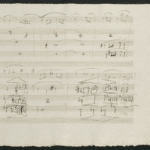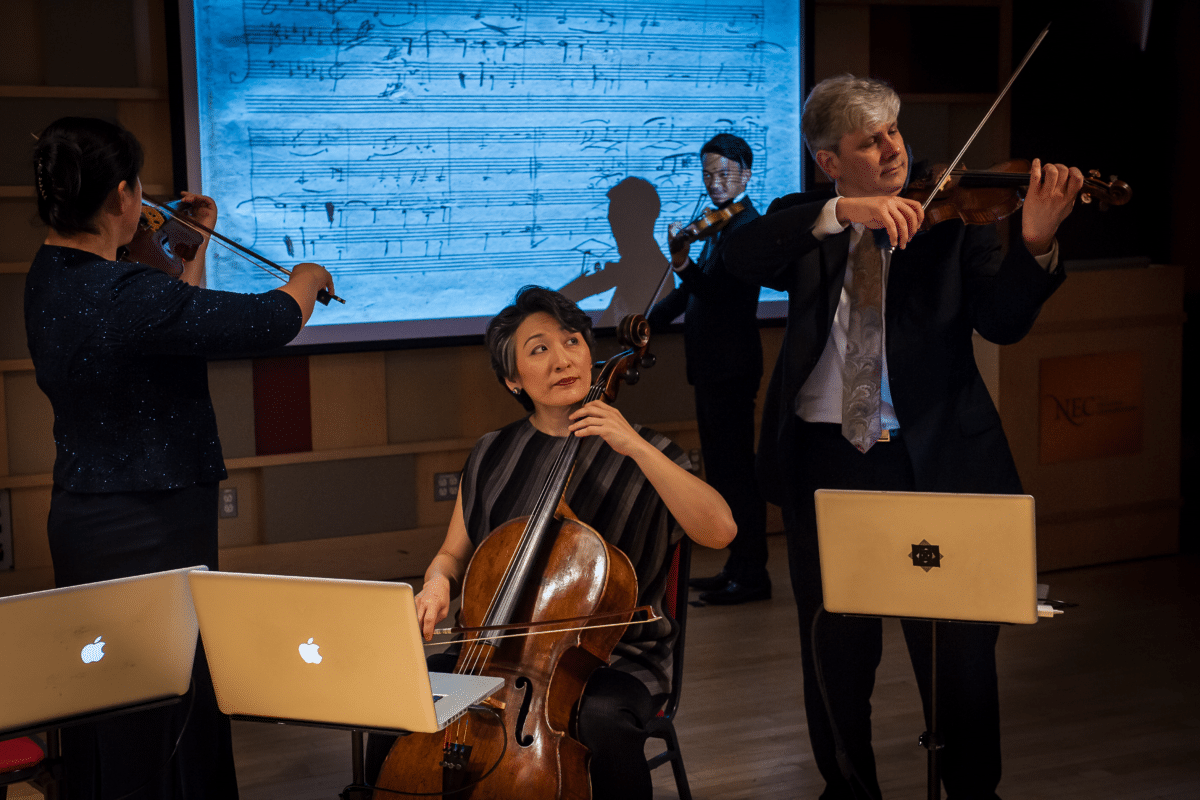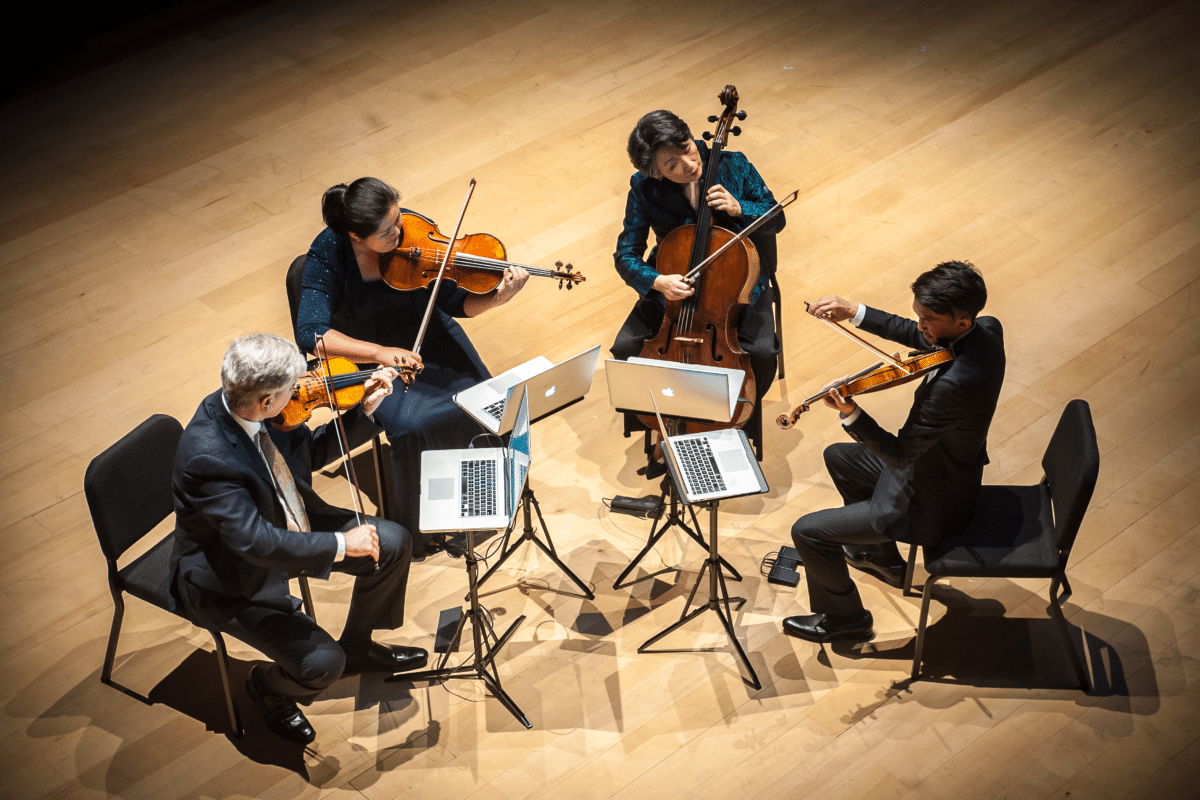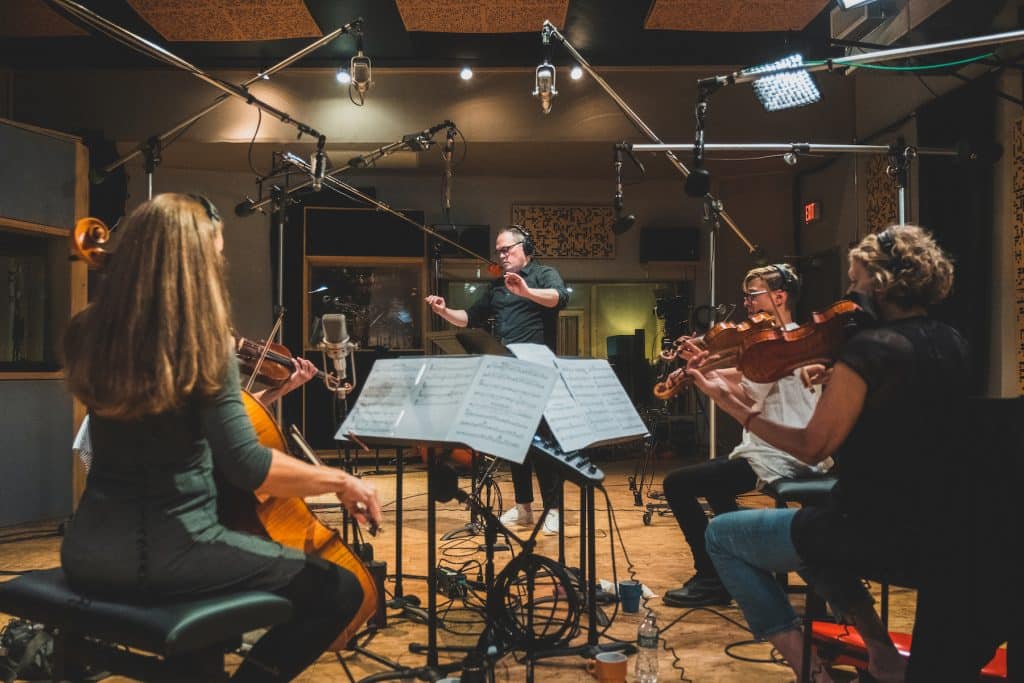Lost Between the Lines
Nicholas Kitchen’s quest to decipher long-hidden markings in Beethoven’s original quartet manuscripts.

“I have a distinct feeling,” says Jeremy Yudkin, “that this is one of those remarkable breakthroughs in music that come only once every few decades.”
Yudkin is co-director of Boston University’s Center for Beethoven Research, and the breakthrough he speaks of has very much to do with Beethoven. For the past six years, Nicholas Kitchen, first violinist of the Borromeo Quartet, has been making discoveries in Beethoven’s manuscripts, what the Borromeos now call “special markings”: instructions from the composer that have been hiding in plain sight for two hundred years. Kitchen’s discoveries are already enriching the performance of Beethoven’s music and casting a new light on his compositional process—with the potential for much more to come.
Exploration and discovery are nothing new for the Borromeos. They’ve been celebrated as pioneers in the replacement of sheet music with computer screens—and now iPads—to enable performance from full score, rather than individual parts. Avidly embracing other technological tools to help listeners and themselves to a fuller musical experience, they project scores for audiences to watch on-screen, burn live recordings for concertgoers wishing to relive the experience, and email with new music composers for daily score updates. Kitchen’s new insights into Beethoven’s old music are a natural outgrowth of this attitude.
In fact, without the intermediate step of full-score reading, Kitchen might never have reached those insights in the first place.
“All my life,” he says, “I’d been thinking, ‘Gosh, I really wish there was a way to play with the whole score.’”
In 2007, Kitchen saw two pianists—Christopher O’Riley and Meng-chieh Liu—perform from computers. “When I was watching, I was just, like, ‘Well, that’s it, that’s how!’”
Right away, he procured mark-able PDF-reading software and a USB foot pedal for the rapid page turns full-score playing requires. (Kitchen now builds his own custom foot pedals.) Soon enough, he found an opportunity to test out the approach.
“We were playing the Reger Clarinet Quintet with Richard Stolzmann. It was unfamiliar to us, so it became very helpful for me to have the score there,” he says. “I was planning to come back to [just] the part when the concert came around. And then everybody said, ‘You know, it’s awfully helpful having you have the score there.’” Before long, the entire quartet was reading from computer.
Meanwhile, about a year earlier, another crucial development was underway: the launch of the International Music Score Library Project (IMSLP), the now ubiquitously-cited online sheet music library. Shortly after his first attempt playing from a computer, Kitchen found a score on IMSLP in Beethoven’s own writing: String Quartet no. 3, Op. 59.
“I didn’t really have a particular plan. But I thought, one rehearsal, ‘why don’t I read off the manuscript today … just to see what it feels like?’”
What it felt like, at first, “was mostly just seeing where he had crossed something out and tried a different option.” Compared with later finds, Beethoven’s edits and erasures provided few revelations, though they were certainly educational.
Borromeo cellist Yeesun Kim notes that “many times, the places we struggle the most in terms of interpretation tend to be in transitional material. The audience needs to be guided between place ‘A’ and place ‘B,’ but in a way that’s not jarring or awkward. We’ve noticed that, in the manuscript, those were exactly the places that Beethoven would struggle.”
But the biggest reveals were still to come. “At the beginning,” admits Kitchen, “I just didn’t see them. There wasn’t a spot for them, so I didn’t recognize that they were there.”
A breakthrough arrived in July of 2013, while Kitchen was coaching a quartet at the Taos School of Music. It was Beethoven’s Op. 132, another piece for which he’d by then procured a manuscript copy. Looking at Beethoven’s handwriting, the quartet’s cellist wondered: “What is this ffmo?”
It was a Eureka moment. “Her question was like flicking a switch. All of a sudden, I saw all these things. I didn’t know quite what to make of them. But I said to myself, ‘Oh my god, there’s a whole other layer of information we haven’t been paying any attention to!’”



Upon further review, the “things” that Kitchen began to see that day divided themselves into three categories: unfamiliar swells, detailed staccatos, and most importantly, unusual dynamics. They can be summarized as follows:
Swells: Beethoven frequently draws a crescendo immediately followed by a diminuendo. (Kitchen sometimes also refers to these symbols as “hairpins.”) In printed scores, such pairs are always what Kitchen calls “open,” with space between the crescendo’s end and the diminuendo’s beginning. But in manuscript, Beethoven sometimes draws what Kitchen labels “closed” swells or “diamonds.”
Staccatos: Beethoven is meticulous in his drawing of staccato marks. Kitchen identifies four varieties: dot, small-line, medium-line, and long-line.
Dynamics: Manuscripts reveal that Beethoven didn’t limit himself to the standard ppp, pp, p, mezzo piano, poco forte, mezzo forte, f, ff, and fff. Rather, he found thirteen other ways to illustrate dynamics. On the quiet end of the spectrum are the fully-written pianissimo and the abbreviated ppmo. Sometimes, the ordinary p, pp, and ppp are modified with either a single- or double-underline. (Kitchen views these underlined dynamics as six discrete markings.) The loud end of the spectrum includes fully-written fortissimo and abbreviated ffmo, as well as fully-written forte and abbreviated for and fo.
There was no question that Kitchen had found something. But what did it mean? To help find out, he immediately set about sharing his discoveries with scholars and fellow musicians.
“I readily admit,” says Yudkin, “that I was skeptical at first—as was everyone else I spoke to.” Borromeo second violinist Khristopher Tong is more blunt: “My first reaction was, ‘Nick is crazy.’”
Still, the Borromeo started rehearsing—and coaching students at New England Conservatory, where the Quartet is in residence—with an eye to making sense of the markings. Meanwhile, a friend, the Beethoven scholar Lewis Lockwood, arranged for Kitchen to spend a week at Beethoven-Haus in Bonn, Germany, perusing manuscripts.
“I’ve looked at every manuscript that I possibly can,” Kitchen affirms. “And it would’ve been very possible that I would come to the conclusion, ‘Oh, okay, it was just in one of these by accident.’ But that’s not at all what I’ve ended up encountering. It is in just score after score after score. And always the same way, and musically seeming to signify always the same things.”
Kitchen has by now found the markings in about fifty scores, beginning with the Op. 30 violin sonatas of 1801-2, and continuing through Beethoven’s last work, the alternate finale of Op.130. Atop this mountain of evidence, he now believes that Beethoven was purposeful and had a unique character in mind for each marking.
Underlines indicate heightened color and emotion. F, fo, and for represent increasing degrees of musical intensity. Ppmo is reserved for the most hushed and rarefied music; ffmo for moments of utmost power. The length of a staccato mark is an indication not necessarily of length, but of how much energy is to be used for a note’s attack. An open swell represents two distinct musical events, a rise in intensity followed by a fall—but a “diamond” indicates a single event, a rise joined to a fall.
One key work reinforces Kitchen’s intuitions: the Missa Solemnis, in which “the words become a kind of Rosetta Stone for figuring out what these marks mean,” he says. “The first ffmo is where he’s talking about Omnipotens—God Almighty.” As the Holy Spirit descends and becomes incarnate in the Virgin Mary, the manuscript is “just littered with pp with two lines. And just at the moment when Christ has been crucified, and there’s a whole section of passus est [“he’s dying”] … the violins go down to their lowest note, the G string, and right there, he’s ppp with two lines.”

At least as important as manuscript study has been practical trial. “With my teaching and the Borromeo’s playing, this is not just idle,” Kitchen says. “It’s actually become this really crucial part of our dialogue with the pieces. We’re testing every one of these things over and over again.”
The quartet’s approach to Beethoven has been altered at both local and architectural levels. Kitchen cites one unison passage in Op. 130 where seeing the marking ffmo simply gives performers a go-ahead to go all out. Of Op. 132’s second movement, Kitchen says: “It’s a beautiful movement, but honestly it can be a little repetitive. And what’s marvelous is these gradations of dynamics and intensities have completely changed that movement, because he goes all sorts of places, all sorts of wonderful contrasts and surprises and back-and-forths and super-fortes.”
At times, Kitchen continues, Beethoven “will set up a heightened intensity very early in the piece, and he’ll top it, he’ll bring it up one level the second time.” For example: “In Op.127, there’s a cadence that sort of concludes the first part, and the first time the first violin has for and the three others have f and the second violin has small staccatos, the viola has medium staccatos, and the cello has big staccatos. That same cadence comes back the second time and it’s now for for the first violin and fo fo fo for the others and all of them have long staccatos.”
Elsewhere in the same work, conversely, Beethoven reserves the special marking for the first iteration of repeating material: “That initial blast of ffmo is very important where it happens. But it would be a little old if you gave it quite that intensity the three other times it happens.”
To Kim, the markings sometimes seem to simply represent what she calls “acoustical reasoning,” as when the most energetic staccatos are given to the cello. She also believes that this new information works best in the context of full-score reading: “If I was given a cello part with all these special markings, I’m not sure I could use it that usefully.”
Tong adds that “the decision on what to do with the information evolves as we live with the piece … It’s not so much that one more millimeter of staccato means that you play it ‘x’ amount shorter … or this many underlines means this many more decibels or less decibels.
“It’s just that there are more layers of information,” he says. “You see the context in the most complex way possible.”
Indeed, there appears no limit to the granular detail Kitchen’s manuscript study reveals. In Op.127 and the Diabelli Variations, for example, he found that Beethoven’s publishers betrayed the composer’s intentions over the matter of beaming (the grouping together of stems for eighth- and sixteenth-notes by means of a horizontal bar.) Because the beaming “is in a completely invisible part of the music,” says Kitchen, “on one level you could say that it doesn’t have any actual meaning. But of course it does have meaning! It’s showing the kind of grammar that he’s feeling underneath what he’s doing.”

Questions remain. Foremost among them: why, in our era of urtexts, has no one noticed these marks before? Kitchen has an answer for this: that Henle Publishers, wonderful as its urtexts are, purposely standardizes all dynamics and staccatos—the legacy, perhaps, of a period when Beethoven’s manuscripts were just being gathered and practical editions first being made from them.
“Of course,” he says, “what I’m bringing up is an editor’s nightmare, because people are going to disagree about whether it’s a medium or a long—and legitimately disagree.”
Similarly confounding: why is there no written evidence that Beethoven’s contemporaries were aware of all this? And, as Yudkin asks, why would such a demanding composer put so much detail into his manuscripts, yet willingly suffer publishers ignoring it? But bolstering the evidentiary case is Kitchen’s discovery that other composers, too, used special markings. Haydn, Mozart, and Schubert all drew several sizes of staccato.
“Schubert uses the underlined pianissimos, and he uses them for what seems to be the exact same thing, a heightened emotion,” Kitchen says. And Mendelssohn and Mozart both employ the “diamond” swell.
Kitchen has at least won over his early doubters. In Yudkin’s estimation, “Nick’s work is astounding. He knows this music better than anyone I know, both as a superb performer and as an obsessive reader and punctilious analyst of the manuscripts themselves.” Tong is similarly convinced. “This information’s definitely there, there’s no disputing it,” he says. “Just take a look yourself.”
Kim finds it unsurprising that an artist like Beethoven “would do his absolute best to try to utilize everything, and go beyond and create his own system.” As a corollary, she hopes “other people realize that, well, yeah, if you are the one who has to write down your thoughts, it’s absolutely natural, and we should pay attention and make sense of it as best we can.”
“Probably by doing so we’d change the way we interpret, change the way we play,” she adds. “I hope so.”
Kitchen himself wonders how other performers might approach the markings. “I can see someone coming up with a totally alternate way of reading those that would be very sincere. But what’s a little strange is that right now there’s no way to even have that discussion.”
To that end, Kitchen’s begun using Sibelius software to create manuscript-based scores from the ground up. Later this year, his Eighth Symphony score will be performed at NEC; Pacific Quartet Vienna and an NEC ensemble have already played his edition of Op. 127. (The Borromeo Quartet will release a new recording of Op. 127 this TK.)
But, as Tong points out, “old habits die hard, especially in a field where so much of what we do celebrates tradition.
“My old heroes in the Guarneri Quartet played off a Peters edition,” he says, “and they sounded great. But that’s not to say if they had that information available to them, they wouldn’t have used it. Of course they would.”
For now, the Borromeos continue to immerse themselves in that unlikeliest thing: new revelation from an old deity. Says Kitchen, “It is literally like Beethoven is looking at me, and asking me to do something.” Naturally, he’s happy to oblige.




